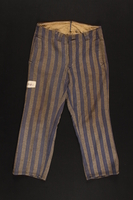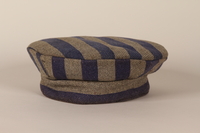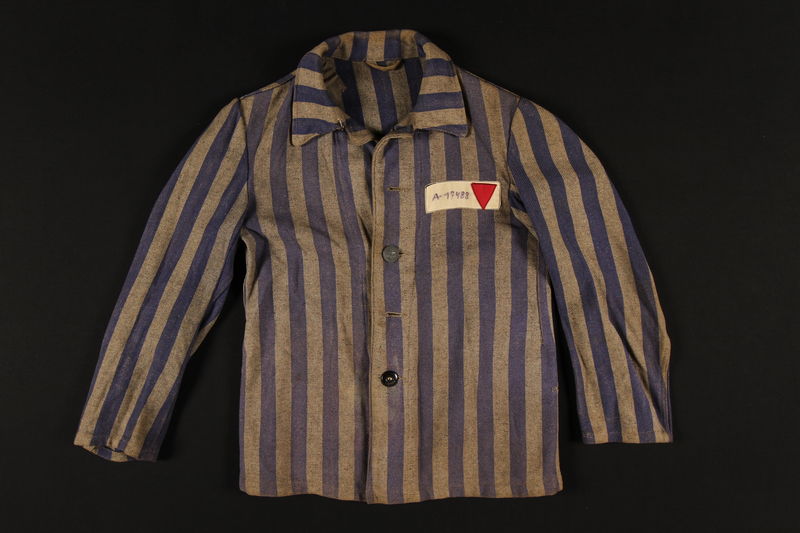Overview
- Brief Narrative
- Striped concentration camp uniform jacket issued to 21-year-old Jakob Lewkowicz in spring 1944, while imprisoned at Blechhammer concentration camp, in German-occupied Poland. Before the Holocaust, Jakob lived with his parents, Judka and Adele Poremba Lewkowicz, in Będzin, Poland. The German army entered their town on September 4, 1939, three days after the invasion of Poland. At the beginning of 1940, Jakob started working for the city administration. Jakob was sent to St. Annaberg (Góra Świętej Anny), Poland, at the end of 1942, where he was registered as a forced laborer. In early 1943, Jakob was sent to Blechhammer forced labor camp in Blechhammer (now Blachownia Slaska), German-occupied Poland. Jakob was still at Blechhammer in spring 1944 when it became a subcamp of Auschwitz III (Buna-Monowitz) concentration camp. On January 21, 1945, the camp was evacuated, and Jakob was sent on a forced march to Gross-Rosen concentration camp, and later transported to Buchenwald and Schörzingen concentration camps in Germany. In mid-April, he was forced to march toward Dachau concentration camp. On April 22, while marching, Jakob was liberated by American soldiers. After the war, Jakob spent time in Saulgau and Rastatt displaced persons camps near Baden, Germany. Jakob sailed to the United States on January 19, 1950.
- Date
-
issue:
approximately 1944
use: approximately 1944-1945 April 22
- Geography
-
issue:
Blechhammer (Concentration camp);
Blachownia Slaska (Poland)
use: Gross-Rosen (Concentration camp); Rogoznica (Wojewodztwo Dolnoslaskie, Poland)
use: Buchenwald (Concentration camp); Weimar (Thuringia, Germany)
use: Schorzingen (Concentration camp); Schorzingen (Germany)
- Credit Line
- United States Holocaust Memorial Museum Collection, Gift of Jakob Lewkowicz
- Markings
- gray button, back, engraved, maker’s mark : OVERHOFF & CO.
- Contributor
-
Subject:
Jakob L. Lewkowicz
Manufacturer: Overhoff & Cie.
- Biography
-
Jakob Lajb Lewkowicz (1922-1996) was born in Będzin, Poland, to Judka (1885-?) and Adele (or Idla) Poremba Lewkowicz. Judka worked as a tailor. While Jakob was growing up, Będzin was home to a large Jewish community. In 1931, the Jewish population numbered 21,625, roughly half of the town’s total population. There were several hundred Jewish-owned factories and workshops, a Jewish press, and primary and secondary schools where lessons were taught in Yiddish and Hebrew. After finishing school, Jakob became a tailor like his father.
On September 1, 1939, Germany invaded Poland, and the army entered Będzin, known by the Germans as Bendsburg, on September 4. On the night of September 8, soldiers burned the Great Synagogue of Będzin, killing over 200 Jews praying within, as well as roughly 50 Jewish houses surrounding the synagogue. Many Jewish residents were also killed by firing squads as they tried to escape or rescue the Torah and other religious books. The physical attacks were followed by repressive economic legislation requiring the Jewish population to relinquish their businesses and personal property. At the beginning of 1940, Jakob started working, without payment, for the city administration in Będzin. In the middle of 1940, Jewish families were systematically removed from houses in the center of the city, and forced to find apartments in a four-block area that served as an open ghetto. In November 1940, the first deportations from Będzin began when all Jews who were not working in local workshops, or for the Jewish council, were required to appear before a medical commission for selection to labor camps. All of the Jews in Regierungsbezirk Kattowitz region, or East Upper Silesia, which included Będzin, were placed at the disposal of the Organization Schmelt run by SS-Oberfuehrer Albrecht Schmelt. The Organization was an extensive program of forced labor that had begun establishing camps for Jews earlier that year. Since Jakob was likely working in a municipal position, he was exempt from these deportations.
In fall 1942, German authorities began preparations to close-off the ghetto, and deported the able-bodied to labor camps. At the end of 1942, Jakob was sent to St. Annaberg (Góra Świętej Anny), Poland, which became the headquarters for Organization Schmelt. Jakob was registered for forced labor and became part of the Reichsarbeitsdienst [National Labor Service]. He was housed in one of 30 forced labor camps in the region carrying out road construction projects. Beginning in 1943, in conjunction with the execution of the Nazi’s “Final Solution,” the most critical of the Organization-managed forced labor camps were converted into concentration camps. The other camps were closed, and those prisoners, including Jakob, were transported to existing concentration camps outside of Organization control. Jakob was sent to Blechhammer forced labor camp in Blechhammer (now Blachownia Slaska), German-occupied Poland. The camp was originally constructed in 1942, in order to supply workers for the Oberschlesische Hydriewerke AG (Upper Silesia Hydrogenation Works). Jakob was still there when it became a subcamp of Auschwitz III (Buna-Monowitz) concentration camp in spring 1944. He was assigned prisoner number A-17488 and a striped concentration camp uniform. The subcamp continued to provide workers for the Oberschlesische Hydriewerke AG. Large portions of this facility were destroyed on September 9, 1944, by American bombers.
On January 21, 1945, the camp was evacuated and Jakob was sent on a 13-day forced march to Gross-Rosen concentration camp. The Soviet Army advanced on the camp, and five days after arriving, Jakob was transferred by train to Buchenwald concentration camp in Germany. On February 10, Jakob arrived at Buchenwald, where he was assigned prisoner number 130322. From March 9-11, 1945, Jakob was transported to Schörzingen concentration camp, one of the Wüste complex of subcamps in the Natzweiler concentration camp system. The main Natzweiler camp located in German-occupied France had been abandoned in September 1944, but its subcamps continued to operate. The Wüste subcamps were part of Unternehmen Wüste [Operation Desert], which was a German fuel project to extract oil from Württemberg shale in the Zollernalb district of Germany. In mid-April 1945, the Wüste camps were all evacuated, and Jakob was sent on a forced march south toward Dachau concentration camp. On April 22, before reaching Dachau, Jakob was liberated by American soldiers. Germany surrendered on May 7, 1945.
After the war, Jakob spent time in a few displaced persons (DP) camps in the French-occupied zone of Germany. He began at the Saulgau DP camp near Baden-Württemberg. This camp was founded by survivors from a subcamp of Dachau. By January 1946, the small community of survivors was living in confiscated or rented apartments and houses throughout the city, and in nearby towns. Jakob likely lived in the town of Ennetach. The camp community was supplied by the United Nations Relief and Rehabilitation Organization (UNRRA) and the American Jewish Joint Distribution Committee (Joint). Beginning in fall 1947, the camp at Saulgau was dissolved, and individuals were sent to larger camps in the area. By March 1949, Jakob was at the Rastatt DP camp near Baden-Baden, Germany. On January 4, 1950, he left Rastatt for Bremen, then to Bremerhaven, where he boarded the USAT General Greeley on January 19. He arrived in New York City on February 2. Jakob settled in the Bronx, and his sponsors helped him secure a job washing dishes at a restaurant in Elizabeth, New Jersey. He commuted there daily using public transportation. Jakob applied for citizenship in April 1955. That same year, he married Maria Konig (1931-2019), whom he had met while still living in French-run DP camps. The couple had two children. Later, Jakob found a job as a tailor and the family eventually relocated to Freehold, New Jersey.
Physical Details
- Classification
-
Clothing and Dress
- Category
-
Concentration camp uniforms
- Object Type
-
Jackets (lcsh)
- Genre/Form
- Prison uniforms.
- Physical Description
- Blue and gray, vertically striped, hip-length, long-sleeved, mediumweight, twill weave cloth jacket. The blue stripes are printed on both sides of the gray cloth, and the seams and hems are machine-stitched with gray thread. The thick, reinforced collar has pointed ends with rounded tips and is fastened with a silver-colored metal hook and eye closure. The front placket has five finished, horizontal buttonholes along the left side. There are two corresponding buttons, one black plastic button and one gray-colored metal one embossed with an anchor, stitched to the right side. The other three buttons are now missing. A rectangular, discolored white cloth patch is stitched to the left breast with black thread. Handwritten in black ink across the patch, is an uppercase letter followed by a five-digit prisoner number and an inverted red triangle. On the interior of the jacket, a gray cloth hanging loop is sewn to the collar. The side seams on the upper chest have been taken in. The overall jacket is faded and stained with many repairs.
- Dimensions
- overall: Height: 24.500 inches (62.23 cm) | Width: 16.250 inches (41.275 cm)
- Materials
- overall : cloth, thread, metal, plastic, ink
- Inscription
- front, left chest, patch, handwritten, black ink : A - 17488
Rights & Restrictions
- Conditions on Access
- No restrictions on access
- Conditions on Use
- No restrictions on use
Keywords & Subjects
- Topical Term
- Concentration camp inmates--Germany--Biography. Concentration camp inmates--Poland--Biography. Deportees--Poland--Bedzin--Biography. Holocaust, Jewish (1939-1945)--Poland--Personal narratives. Holocaust survivors--United States--Biography. Labor camps--Poland. Refugee camps--Germany. World War, 1939-1945--Deportations from Poland.
Administrative Notes
- Legal Status
- Permanent Collection
- Provenance
- The uniform jacket was donated to the United States Holocaust Memorial Museum in 1995 by Jakob Lewkowicz.
- Funding Note
- The cataloging of this artifact has been supported by a grant from the Conference on Jewish Material Claims Against Germany.
- Record last modified:
- 2022-07-28 18:34:12
- This page:
- https://collections.ushmm.org/search/catalog/irn9868
Also in Jakob Lewkowicz collection
The collection consists of a concentration camp uniform jacket, pants, and cap and two publications relating to the experiences of Jakob Lewkowicz in forced labor camps and Blechhammer, Gross-Rosen, Buchenwald, and Schörzingen concentration camps during the Holocaust.
Date: approximately 1944-approximately 1947

Concentration camp uniform pants worn by a Polish Jewish prisoner
Object
Striped concentration camp uniform pants issued to 21-year-old Jakob Lewkowicz in spring 1944, while imprisoned at Blechhammer concentration camp, in German-occupied Poland. Before the Holocaust, Jakob lived with his parents, Judka and Adele Poremba Lewkowicz, in Będzin, Poland. The German army entered their town on September 4, 1939, three days after the invasion of Poland. At the beginning of 1940, Jakob started working for the city administration. Jakob was sent to St. Annaberg (Góra Świętej Anny), Poland, at the end of 1942, where he was registered as a forced laborer. In early 1943, Jakob was sent to Blechhammer forced labor camp in Blechhammer (now Blachownia Slaska), German-occupied Poland. Jakob was still at Blechhammer in spring 1944 when it became a subcamp of Auschwitz III (Buna-Monowitz) concentration camp. On January 21, 1945, the camp was evacuated, and Jakob was sent on a forced march to Gross-Rosen concentration camp, and later transported to Buchenwald and Schörzingen concentration camps in Germany. In mid-April, he was forced to march toward Dachau concentration camp. On April 22, while marching, Jakob was liberated by American soldiers. After the war, Jakob spent time in Saulgau and Rastatt displaced persons camps near Baden, Germany. Jakob sailed to the United States on January 19, 1950.

Concentration camp uniform cap worn by a Polish Jewish prisoner
Object
Striped concentration camp uniform cap issued to 21-year-old Jakob Lewkowicz in spring 1944, while imprisoned at Blechhammer concentration camp, in German-occupied Poland. Before the Holocaust, Jakob lived with his parents, Judka and Adele Poremba Lewkowicz, in Będzin, Poland. The German army entered their town on September 4, 1939, three days after the invasion of Poland. At the beginning of 1940, Jakob started working for the city administration. Jakob was sent to St. Annaberg (Góra Świętej Anny), Poland, at the end of 1942, where he was registered as a forced laborer. In early 1943, Jakob was sent to Blechhammer forced labor camp in Blechhammer (now Blachownia Slaska), German-occupied Poland. Jakob was still at Blechhammer in spring 1944 when it became a subcamp of Auschwitz III (Buna-Monowitz) concentration camp. On January 21, 1945, the camp was evacuated, and Jakob was sent on a forced march to Gross-Rosen concentration camp, and later transported to Buchenwald and Schörzingen concentration camps in Germany. In mid-April, he was forced to march toward Dachau concentration camp. On April 22, while marching, Jakob was liberated by American soldiers. After the war, Jakob spent time in Saulgau and Rastatt displaced persons camps near Baden, Germany. Jakob sailed to the United States on January 19, 1950.
Pictorial report of concentration camps acquired postwar by a former Polish Jewish prisoner
Object
A copy of the “KZ: Bildbericht aus fünf Konzentrationslagern” [KZ: Pictorial report of five concentration camps,] owned by Jakob Lewkowicz, who spent several years as a concentration camp prisoner. It was published soon after the war by the American War Information Office to increase awareness of the atrocities that had occurred. It contains post-liberation photographs at Buchenwald, Bergen-Belsen, Nordhausen, and Ohrdruf concentration camps and the site of the Gardelagen massacre. Jakob’s name and those of others, likely his relatives, are inscribed within. Before the Holocaust, Jakob lived with his parents in Będzin, Poland. The German army entered their town on September 4, 1939, three days after the invasion of Poland. At the beginning of 1940, Jakob started working for the city administration. Jakob was sent to St. Annaberg (Góra Świętej Anny), Poland, at the end of 1942, where he was registered as a forced laborer. In early 1943, Jakob was sent to Blechhammer forced labor camp in Blechhammer (now Blachownia Slaska), German-occupied Poland. Jakob was still at Blechhammer in spring 1944 when it became a subcamp of Auschwitz III (Buna-Monowitz) concentration camp. On January 21, 1945, the camp was evacuated, and Jakob was sent on a forced march to Gross-Rosen concentration camp, and later transported to Buchenwald and Schörzingen concentration camps in Germany. In mid-April, he was forced to march toward Dachau concentration camp. On April 22, while marching, Jakob was liberated by American soldiers. After the war, Jakob spent time in Saulgau and Rastatt displaced persons camps near Baden, Germany. Jakob sailed to the United States on January 19, 1950.
Book of sketches printed postwar and acquired by a former Polish Jewish prisoner
Object
A copy of “Tsurik fun Gehenem: 22 tseykhenungen fun Berl Friedler” [Back from Hell : 22 collected sketches by Berl Friedler,] published in 1947 and owned by Jakob Lewkowicz, who spent who spent several years as a concentration camp prisoner. The bound book contains a series of 21 color-printed, chronological sketches drawn and published by Holocaust survivor Berl Fridler. The sketches are preceded by a Yiddish-language forward written by Paul Trepman. Before the Holocaust, Jakob lived with his parents in Będzin, Poland. The German army entered their town on September 4, 1939, three days after the invasion of Poland. At the beginning of 1940, Jakob started working for the city administration. Jakob was sent to St. Annaberg (Góra Świętej Anny), Poland, at the end of 1942, where he was registered as a forced laborer. In early 1943, Jakob was sent to Blechhammer forced labor camp in Blechhammer (now Blachownia Slaska), German-occupied Poland. Jakob was still at Blechhammer in spring 1944 when it became a subcamp of Auschwitz III (Buna-Monowitz) concentration camp. On January 21, 1945, the camp was evacuated, and Jakob was sent on a forced march to Gross-Rosen concentration camp, and later transported to Buchenwald and Schörzingen concentration camps in Germany. In mid-April, he was forced to march toward Dachau concentration camp. On April 22, while marching, Jakob was liberated by American soldiers. After the war, Jakob spent time in Saulgau and Rastatt displaced persons camps near Baden, Germany. Jakob sailed to the United States on January 19, 1950.




